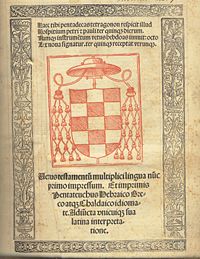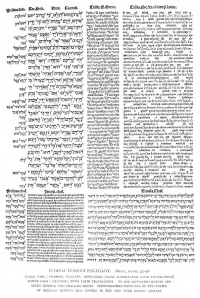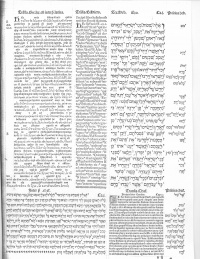Complutensian Polyglot Bible
From Textus Receptus
(→Contents) |
|||
| Line 1: | Line 1: | ||
[[Image:200px_original_complutensian_polyglot_Bible_-1.jpg|thumb|200px|right|The first page of the Complutensian Polyglot]] | [[Image:200px_original_complutensian_polyglot_Bible_-1.jpg|thumb|200px|right|The first page of the Complutensian Polyglot]] | ||
[[image:Complutesian Polyglot 1522.jpg|thumb|right|200px|Page from ''Complutensian Polyglot'']] | [[image:Complutesian Polyglot 1522.jpg|thumb|right|200px|Page from ''Complutensian Polyglot'']] | ||
| - | The Complutensian Polyglot Bible is the name given to the first printed polyglot of the entire [[Bible]], initiated and financed by [[Cardinal Francisco Jiménez de Cisneros]] (1436-1517). It includes the first printed editions of the [[Greek New Testament]], the complete [[Septuagint]], and the [[Targum Onkelos]]. Of the 600 printed, only 123 are known to have survived to date. | + | The Complutensian Polyglot Bible is the name given to the first printed polyglot of the entire [[Bible]], initiated and financed by [[Cardinal Francisco Jiménez de Cisneros]] ([[1436 AD|1436]]-[[1517 AD|1517]]). It includes the first printed editions of the [[Greek New Testament]], the complete [[Septuagint]], and the [[Targum Onkelos]]. Of the 600 printed, only 123 are known to have survived to date. |
==History== | ==History== | ||
| - | With the rise of the printing press in the 1450s, | + | With the rise of the printing press in the 1450s, the Bible could be propagated much more efficiently. At great personal expense, [[Cardinal Francisco Jiménez de Cisneros|Cardinal Cisneros]] acquired many manuscripts and invited the top religious scholars of the day, including [[Hernán Nuñez]], to work on the ambitious task of compiling a massive and complete polyglot "to revive the languishing study of the Sacred Scriptures." The scholars met in the city of Alcalá de Henares (in [[Latin]], ''Complutum''), at the Cardinal's own University of Alcalá. Work on the project began in [[1502 AD|1502]] under the direction of [[Diego Lopez de Zúñiga]], and continued there for fifteen years. |
The [[New Testament]] was completed and printed in [[1514 AD|1514]], but its publication was delayed while work on the [[Old Testament]] continued, so they could be published together as a complete work. In the meantime, word of the Complutensian project reached [[Desiderius Erasmus]] in Rotterdam, who produced his own printed edition of the Greek New Testament. [[Desiderius Erasmus|Erasmus]] obtained an exclusive four-year publishing privilege from Emperor Maximilian and Pope Leo X in [[1516 AD|1516]]. [[Desiderius Erasmus|Erasmus]]' text became known as the [[Textus Receptus]], and later editions were the basis for the [[King James Version]] of the [[New Testament]]. | The [[New Testament]] was completed and printed in [[1514 AD|1514]], but its publication was delayed while work on the [[Old Testament]] continued, so they could be published together as a complete work. In the meantime, word of the Complutensian project reached [[Desiderius Erasmus]] in Rotterdam, who produced his own printed edition of the Greek New Testament. [[Desiderius Erasmus|Erasmus]] obtained an exclusive four-year publishing privilege from Emperor Maximilian and Pope Leo X in [[1516 AD|1516]]. [[Desiderius Erasmus|Erasmus]]' text became known as the [[Textus Receptus]], and later editions were the basis for the [[King James Version]] of the [[New Testament]]. | ||
| - | The Complutensian Old Testament was completed in 1517. Because of [[Desiderius Erasmus|Erasmus]]' exclusive privilege, publication of the Polyglot was delayed until Pope Leo X could sanction it in 1520. It is believed to have not been distributed widely before 1522. Cardinal Cisneros died in July of 1517, five months after the Polyglot's completion, and never saw its publication. | + | The Complutensian Old Testament was completed in [[1517 AD|1517]]. Because of [[Desiderius Erasmus|Erasmus]]' exclusive privilege, publication of the Polyglot was delayed until Pope Leo X could sanction it in 1520. It is believed to have not been distributed widely before 1522. Cardinal Cisneros died in July of [[1517 AD|1517]], five months after the Polyglot's completion, and never saw its publication. |
[[Image:Cisneros' original complutensian polyglot Bible -2.jpg|thumb|200px|Other page from ''Bibbia Poliglotta Complutense'']] | [[Image:Cisneros' original complutensian polyglot Bible -2.jpg|thumb|200px|Other page from ''Bibbia Poliglotta Complutense'']] | ||
==Contents== | ==Contents== | ||
| - | The Complutensian Polyglot Bible was published as a six-volume set. The first four volumes contain the [[Old Testament]]. Each page consists of three parallel columns of text: Hebrew on the outside, the [[Latin | + | The Complutensian Polyglot Bible was published as a six-volume set. The first four volumes contain the [[Old Testament]]. Each page consists of three parallel columns of text: [[Hebrew]] on the outside, the [[Latin Vulgate]] in the middle, and the [[Greek]] [[Septuagint]] on the inside. On each page of the [[Pentateuch]], the Aramaic text (the [[Targum Onkelos]]) and its own [[Latin]] translation are added at the bottom. The fifth volume, the [[New Testament]], consists of parallel columns of [[Greek]] and the [[Latin Vulgate]]. The sixth volume contains various [[Hebrew]], [[Aramaic]], and [[Greek]] dictionaries and study aids. Although many of the manuscripts used are probably lost in time, some remaining [[Greek]] [[Minuscule|Minuscules]] which were probably used are: [[Minuscule 140]], [[Minuscule 234]], and [[Minuscule 432]]. |
[[Jerome]]'s version of the [[Old Testament]] was placed between the [[Greek]] and [[Hebrew]] versions, thus the synagogue and the Eastern church, as the preface explains it, are set like the thieves on this side and on that, with Jesus (that is, the Roman Church) in the midst. | [[Jerome]]'s version of the [[Old Testament]] was placed between the [[Greek]] and [[Hebrew]] versions, thus the synagogue and the Eastern church, as the preface explains it, are set like the thieves on this side and on that, with Jesus (that is, the Roman Church) in the midst. | ||
| - | A magnificent full size (folio) facsimile edition was published in Valencia 1984-87. It is reproduced for the Bible text (volumes 1-5) from the copy in the Library of the Jesuit Society at Rome; the rare sixth volume with dictionaries has been reproduced from the copy in the Madrid University Library. | + | A magnificent full size (folio) facsimile edition was published in Valencia [[1984 AD|1984]]-[[1987 AD|87]]. It is reproduced for the Bible text (volumes 1-5) from the copy in the Library of the [[Society of Jesus|Jesuit Society at Rome]]; the rare sixth volume with dictionaries has been reproduced from the copy in the Madrid University Library. |
| - | The typeface devised for the Complutensian by Arnaldo Guillén de Brocar has been regarded by typographers such as Robert Proctor as the apex of [[Greek]] typographical development in early printing, before Aldus Manutius' manuscript-based typefaces took over the market for the next two centuries. Proctor based his [[1903 AD|1903]] Otter Greek typeface on the Polyglot; the Greek Font Society's GFS Complutensian | + | The typeface devised for the Complutensian by [[Arnaldo Guillén de Brocar]] has been regarded by typographers such as [[Robert Proctor]] as the apex of [[Greek]] typographical development in early printing, before [[Aldus Manutius]]' manuscript-based typefaces took over the market for the next two centuries. Proctor based his [[1903 AD|1903]] Otter Greek typeface on the Polyglot; the [[Greek Font Society]]'s'' GFS Complutensian Greek'' is likewise based on the Polyglot. |
== See also == | == See also == | ||
* [[Novum Instrumentum omne]] | * [[Novum Instrumentum omne]] | ||
* [[Editio Regia]] | * [[Editio Regia]] | ||
| + | * [[Codex Complutensis I]] | ||
== External links == | == External links == | ||
Revision as of 01:03, 22 January 2011
The Complutensian Polyglot Bible is the name given to the first printed polyglot of the entire Bible, initiated and financed by Cardinal Francisco Jiménez de Cisneros (1436-1517). It includes the first printed editions of the Greek New Testament, the complete Septuagint, and the Targum Onkelos. Of the 600 printed, only 123 are known to have survived to date.
Contents |
History
With the rise of the printing press in the 1450s, the Bible could be propagated much more efficiently. At great personal expense, Cardinal Cisneros acquired many manuscripts and invited the top religious scholars of the day, including Hernán Nuñez, to work on the ambitious task of compiling a massive and complete polyglot "to revive the languishing study of the Sacred Scriptures." The scholars met in the city of Alcalá de Henares (in Latin, Complutum), at the Cardinal's own University of Alcalá. Work on the project began in 1502 under the direction of Diego Lopez de Zúñiga, and continued there for fifteen years.
The New Testament was completed and printed in 1514, but its publication was delayed while work on the Old Testament continued, so they could be published together as a complete work. In the meantime, word of the Complutensian project reached Desiderius Erasmus in Rotterdam, who produced his own printed edition of the Greek New Testament. Erasmus obtained an exclusive four-year publishing privilege from Emperor Maximilian and Pope Leo X in 1516. Erasmus' text became known as the Textus Receptus, and later editions were the basis for the King James Version of the New Testament.
The Complutensian Old Testament was completed in 1517. Because of Erasmus' exclusive privilege, publication of the Polyglot was delayed until Pope Leo X could sanction it in 1520. It is believed to have not been distributed widely before 1522. Cardinal Cisneros died in July of 1517, five months after the Polyglot's completion, and never saw its publication.
Contents
The Complutensian Polyglot Bible was published as a six-volume set. The first four volumes contain the Old Testament. Each page consists of three parallel columns of text: Hebrew on the outside, the Latin Vulgate in the middle, and the Greek Septuagint on the inside. On each page of the Pentateuch, the Aramaic text (the Targum Onkelos) and its own Latin translation are added at the bottom. The fifth volume, the New Testament, consists of parallel columns of Greek and the Latin Vulgate. The sixth volume contains various Hebrew, Aramaic, and Greek dictionaries and study aids. Although many of the manuscripts used are probably lost in time, some remaining Greek Minuscules which were probably used are: Minuscule 140, Minuscule 234, and Minuscule 432.
Jerome's version of the Old Testament was placed between the Greek and Hebrew versions, thus the synagogue and the Eastern church, as the preface explains it, are set like the thieves on this side and on that, with Jesus (that is, the Roman Church) in the midst.
A magnificent full size (folio) facsimile edition was published in Valencia 1984-87. It is reproduced for the Bible text (volumes 1-5) from the copy in the Library of the Jesuit Society at Rome; the rare sixth volume with dictionaries has been reproduced from the copy in the Madrid University Library.
The typeface devised for the Complutensian by Arnaldo Guillén de Brocar has been regarded by typographers such as Robert Proctor as the apex of Greek typographical development in early printing, before Aldus Manutius' manuscript-based typefaces took over the market for the next two centuries. Proctor based his 1903 Otter Greek typeface on the Polyglot; the Greek Font Society's GFS Complutensian Greek is likewise based on the Polyglot.
See also
External links
- Catholic Encyclopedia: Editions of the Bible
- Catholic Encyclopedia "Polyglot Bibles"
- DUKE Magazine
- GFS Complutensian Greek
- Robert Proctor's announcement of his Otter Greek font: A New Fount of Greek Type, Burlington Magazine for Connoisseurs, Vol. 2, No. 6 (Aug., 1903), pp. 358-360
- Blog entry on Complutensian typography
- Download the Complutensian Polyglot Bible in PDF Format



